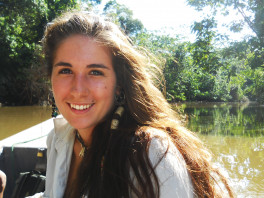When Disciplines Collide—and Flourish
I’m going to be upfront with you: academically, I’m a little all over the place. But I see that as an advantage rather than a problem. You see, I get a kick out of understanding the world. And, it turns out, the world involves a lot more than one subject.

I’m going to be upfront with you: academically, I’m a little all over the place. But I see that as an advantage rather than a problem. You see, I get a kick out of understanding the world. And, it turns out, the world involves a lot more than one subject.
I started out as a chemistry major, then I studied evolution, then went back to structural biochemistry, and then shifted to ecology. In my studies, I’ve been going back and forth between big-scale patterns and small-scale explanations. Fortunately, I finally found my niche in our school’s microbial ecology lab: microbes (small), ecology (big). Perfect.
All along the way, I entertained an environmental studies minor on the side, took a couple of philosophy courses, and tried my hand at geology. Somehow, I’ve made it out of this marvelous mix with a degree called “biology,” but I much prefer my self-proclaimed title “biogeochemistry philosopher of environmentalism.”
But that’s just the part that shows up on the transcript.
For me, interdisciplinarity extends well beyond the classroom. To highlight how valuable experiential learning can be, I’m going to take you on a quick tour through my experiences in three very different, yet equally amazing, bioregions of the planet: Ecuador, Oregon, and New Zealand.
The summer after my sophomore year, I went to Ecuador as a research intern with the Amazon Mycorenewal Project, a collaboration of biologists, permaculturists, and sociologists who focus on oil bioremediation in the Ecuadorian rainforest. In other words, they’re cleaning up oil spills with mushrooms. One moment, in particular, stands out to me: I remember standing at the edge of a contamination site, suited up in a gas mask and covered in tar. I was sweaty and exhausted—and thrilled to realize that I was still full of enthusiasm and vigor for the work I was doing. I knew that my work and research would have tangible, beneficial outcomes, and I felt connected to the global implications of the issue we were addressing. This internship helped confirm I was on the right career path.
That fall, I came back to Lewis & Clark and started working in Assistant Professor Peter Kennedy’s microbial research lab. We studied mycorrhizae, an amazing symbiotic relationship between the trees in our forests and the fungi (mushrooms) that live in the soil and attach to their roots. Together, Peter and I went out into old-growth forests throughout the Cascades to find these mushrooms and learn about their ecosystems. You think you know what teaching looks like, but imagine this: Peter and I are crawling on our hands and knees under the foliage of a large Doug fir tree, scooting on our bellies to grab the oh-so-fascinating slimy wet mushroom nestled in the soil. Holding it up for Peter’s inspection, I ask: “Bolete?” No. “Suillus?” No. “Cortinarius?” Yes! A few minutes later, looking at a root: “What’s this orange bit? Is that a bacteria nodule!? No way!”
During this same semester, I was also working as a trip leader and peer environmental educator for College Outdoors. I always incorporate local ecology, geology, and history into the trips I teach. I’ve learned that by engaging participants both intellectually and physically with their environment, both experiences are amplified. Hiking into the same amazing forests that I was studying in the lab, I had the wonderful opportunity to take my first-hand learning experience and turn it into experiential learning for others. “See that little orange knobby thing on the root here? That’s a nitrogen-fixing bacteria nodule!”
Finally, in the spring of my junior year, I participated in a biology-oriented overseas study program in New Zealand. Picture this: two days into my trip, I am sitting on a kayak, deep in the Fjordlands National Park. All around me—and continuing hundreds of miles to the north and south—are sheer cliffs, thousands of feet high, rising straight up out of the water. Ten of my classmates are on kayaks next to me, and our New Zealand–based professor is in the middle, teaching us about the unique marine life living on the cliff walls. As if on cue, a seabird flies above us. And I realize I am in school right now.
You don’t have to be a biogeochemist to know that having the opportunity to experience the world firsthand—to connect ideas and practice applying them to what you see—is invaluable. For me, it’s also been life-changing. I have worked hard along the way, but I’ve only been able to do all of this with the support of Lewis & Clark and its many friends and donors.
Thank you for the amazing gift that is our College Outdoors program, thank you for the opportunity to travel and see the world, thank you for enabling us to conduct research and ask new questions, thank you for making it possible for us to synthesize our interests and figure out who we are going to be and how we are going to give back. Thank you.
Adapted from Huggins’ comments at Lewis & Clark’s Scholarship Recognition Luncheon on April 16, 2013.
More L&C Magazine Stories
Lewis & Clark Magazine is located in McAfee on the Undergraduate Campus.
MSC: 19
email magazine@lclark.edu
voice 503-768-7970
fax 503-768-7969
The L&C Magazine staff welcomes letters and emails from readers about topics covered in the magazine. Correspondence must include your name and location and may be edited.
Lewis & Clark Magazine
Lewis & Clark
615 S. Palatine Hill Road MSC 19
Portland OR 97219

